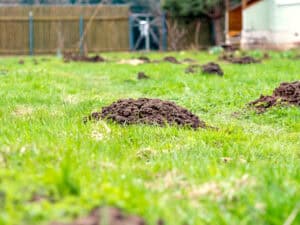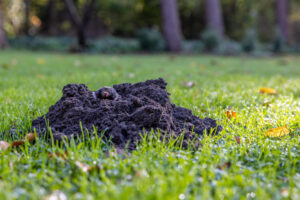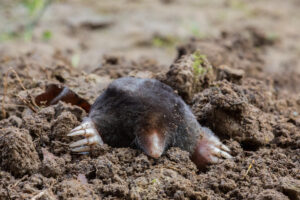
Moles are small, burrowing mammals known for their velvety fur, streamlined bodies, and intricate tunnels they create in search of food. While moles are intriguing creatures, homeowners often view them as pests due to the damage they can cause to lawns and gardens. But are moles as harmful as they’re made out to be?
In this blog post, we will explore the impacts of moles on your lawn and garden and potential strategies for managing them.
Moles: Friend or Foe?
Moles are insectivores that feed on earthworms, grubs, and other soil-dwelling insects. They can benefit your garden by consuming pests that could otherwise damage your plants. Additionally, moles’ tunneling activities can help aerate the soil, promoting healthier root growth and improving drainage.
However, the same tunneling behavior that makes moles helpful in some respects can also cause significant damage to your lawn and garden. As moles burrow through the soil, they create raised ridges and mounds known as molehills, which can disrupt the aesthetics of your property or displace plants in your garden.
Furthermore, the tunnels can cause plant root damage, leading to wilting or even death. This combination of positive and negative impacts makes the presence of moles in your lawn and garden a subject of debate.
Lawn Damage: A Closer Look
The most noticeable sign of a mole infestation in your lawn is the presence of molehills—small mounds of soil that result from moles pushing their way through the ground. Molehills can vary in size but generally measure about 6 inches in diameter and 2 inches in height.
While these mounds can be an eyesore, they usually don’t cause any long-term damage to your grass. However, the raised ridges created by moles’ tunneling can lead to uneven ground and damaged grass roots, resulting in dead or yellowing grass patches.
It’s also worth noting that moles are often blamed for damage caused by other animals. For example, voles and shrews are known to use mole tunnels as their own, and these creatures may cause more direct harm to your plants by feeding on roots and bulbs.
If you’re experiencing significant damage to your lawn or garden, it’s essential to accurately identify the culprit before taking mole extermination.
How to Minimize Mole Damage
If you’ve determined that the damage caused by moles in your lawn and garden outweighs their potential benefits, there are several mole extermination steps you can take to minimize their impact:
- Implement Natural Deterrents: Various natural mole repellents can discourage moles from tunneling in your yard. Castor oil-based products, for example, can be applied to your lawn to create an unpleasant environment for moles. Other deterrents include planting mole-repelling plants such as daffodils, marigolds, or alliums, which emit a smell that moles find offensive.
- Encourage Predators: Attracting natural predators of moles, such as owls, hawks, and snakes, can help reduce their populations in your yard. Installing owl or hawk nesting boxes, and providing cover and habitat for snakes, can encourage these predators to reside in your area.
- Maintain a Healthy Lawn: A well-maintained lawn is less likely to be attractive to moles. Regular mowing, watering, and fertilizing can help keep your grass healthy and less susceptible to damage from moles and other pests. Additionally, reducing the amount of water you apply to your lawn can help discourage earthworms, a food source for moles.
- Trap and Relocate: If mole populations continue to be a problem, several humane traps can be used to capture and relocate moles to a more suitable location. Follow local regulations regarding mole trapping and relocation.
- Consult a Professional: If your efforts to control moles in your lawn and garden are unsuccessful, consulting a professional pest control company may be necessary. They can evaluate your situation and recommend the most effective solutions for your property.
Conclusion
While moles can cause some damage to your lawn and garden, they are not the destructive pests they are often made out to be. By understanding their role in the ecosystem and implementing some preventative measures, you can minimize their impact on your landscape while still enjoying their benefits, such as aerating the soil and controlling insect populations. With the right mole extermination approach, you can find a balance that allows you to coexist peacefully with these unique and helpful creatures.
If you are facing a mole infestation in the Cincinnati, Dayton, Springfield, Indiana, Wilmington, and Northern KY areas, look no further than Trap Your Moles, the best mole-trapping professionals in the region. With our extensive mole extermination experience, highly trained staff, and state-of-the-art trapping techniques, we ensure effective and humane mole removal. Contact us today for the ultimate solution to your mole problems.







No comment yet, add your voice below!